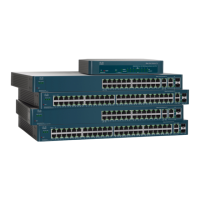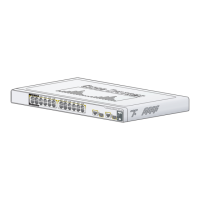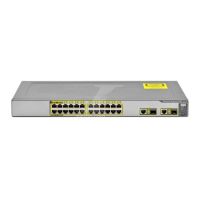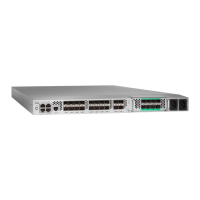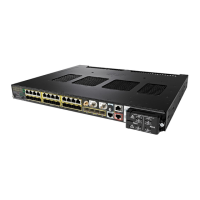Administration: Stack Management
Unit Failure in Stack
81 Cisco 500 Series Stackable Managed Switch Administration Guide
5
For the backup to be able to take the place of the master, both units maintain a
warm standby at all times. In warm standby, the master and its backup units are
synchronized with the static configuration (contained in both the Startup and
Running configuration files). Backup configuration files are not synchronized. The
backup configuration file remains on the previous master.
Dynamic process-state information, such as the STP state table, dynamically-
learned MAC addresses, dynamically-learned Smartport types, MAC Multicast
tables, LACP, and GVRP are not synchronized.
When a master is being configured, it synchronizes the backup immediately.
Synchronization is performed as soon as a command is executed. This is
transparent.
If a unit is inserted into a running stack, and is selected as a backup unit, the master
synchronizes it so that it has an up-to date configuration, and then generates a
SYNC COMPLETE SYSLOG message. This is a unique SYSLOG message that
appears only when backup is converging with the master unit, and looks like this:
%DSYNCH-I-SYNCH_SUCCEEDED: Synchronization with unit 2 is finished
successfully.
Master/Backup Switchover
When a master fails or when you configure a force master on the backup unit, a
switchover occurs.
The backup unit becomes the master, and all of its processes and protocol stacks
are initialized to take responsibility for the entire stack. As a result, there is
temporarily no traffic forwarding in this unit, but slave units remain active.
NOTE When STP is used and the ports are in link up, the STP port’s state is temporarily
Blocking, and it cannot forward traffic or learn MAC addresses. This is to prevent
spanning tree loops between active units.
Slave Unit Handling
While the backup becomes the master, the active slave units remain active and
continue to forward packets based on the configuration from the original master.
This minimizes data traffic interruption in units.
After the backup unit has completed the transition to the master state, it initializes
the slave units one at a time by performing the following operations:
• Clear and reset the configuration of the slave unit to default (to prevent an
incorrect configuration from the new master unit). As a result, there is no
traffic forwarding on the slave unit.
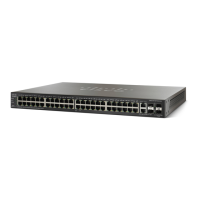
